Ka-Hei Hui
OPA-Pack: Object-Property-Aware Robotic Bin Packing
May 19, 2025Abstract:Robotic bin packing aids in a wide range of real-world scenarios such as e-commerce and warehouses. Yet, existing works focus mainly on considering the shape of objects to optimize packing compactness and neglect object properties such as fragility, edibility, and chemistry that humans typically consider when packing objects. This paper presents OPA-Pack (Object-Property-Aware Packing framework), the first framework that equips the robot with object property considerations in planning the object packing. Technical-wise, we develop a novel object property recognition scheme with retrieval-augmented generation and chain-of-thought reasoning, and build a dataset with object property annotations for 1,032 everyday objects. Also, we formulate OPA-Net, aiming to jointly separate incompatible object pairs and reduce pressure on fragile objects, while compacting the packing. Further, OPA-Net consists of a property embedding layer to encode the property of candidate objects to be packed, together with a fragility heightmap and an avoidance heightmap to keep track of the packed objects. Then, we design a reward function and adopt a deep Q-learning scheme to train OPA-Net. Experimental results manifest that OPA-Pack greatly improves the accuracy of separating incompatible object pairs (from 52% to 95%) and largely reduces pressure on fragile objects (by 29.4%), while maintaining good packing compactness. Besides, we demonstrate the effectiveness of OPA-Pack on a real packing platform, showcasing its practicality in real-world scenarios.
Rethinking End-to-End 2D to 3D Scene Segmentation in Gaussian Splatting
Mar 18, 2025Abstract:Lifting multi-view 2D instance segmentation to a radiance field has proven to be effective to enhance 3D understanding. Existing methods rely on direct matching for end-to-end lifting, yielding inferior results; or employ a two-stage solution constrained by complex pre- or post-processing. In this work, we design a new end-to-end object-aware lifting approach, named Unified-Lift that provides accurate 3D segmentation based on the 3D Gaussian representation. To start, we augment each Gaussian point with an additional Gaussian-level feature learned using a contrastive loss to encode instance information. Importantly, we introduce a learnable object-level codebook to account for individual objects in the scene for an explicit object-level understanding and associate the encoded object-level features with the Gaussian-level point features for segmentation predictions. While promising, achieving effective codebook learning is non-trivial and a naive solution leads to degraded performance. Therefore, we formulate the association learning module and the noisy label filtering module for effective and robust codebook learning. We conduct experiments on three benchmarks: LERF-Masked, Replica, and Messy Rooms datasets. Both qualitative and quantitative results manifest that our Unified-Lift clearly outperforms existing methods in terms of segmentation quality and time efficiency. The code is publicly available at \href{https://github.com/Runsong123/Unified-Lift}{https://github.com/Runsong123/Unified-Lift}.
WonderVerse: Extendable 3D Scene Generation with Video Generative Models
Mar 13, 2025Abstract:We introduce \textit{WonderVerse}, a simple but effective framework for generating extendable 3D scenes. Unlike existing methods that rely on iterative depth estimation and image inpainting, often leading to geometric distortions and inconsistencies, WonderVerse leverages the powerful world-level priors embedded within video generative foundation models to create highly immersive and geometrically coherent 3D environments. Furthermore, we propose a new technique for controllable 3D scene extension to substantially increase the scale of the generated environments. Besides, we introduce a novel abnormal sequence detection module that utilizes camera trajectory to address geometric inconsistency in the generated videos. Finally, WonderVerse is compatible with various 3D reconstruction methods, allowing both efficient and high-quality generation. Extensive experiments on 3D scene generation demonstrate that our WonderVerse, with an elegant and simple pipeline, delivers extendable and highly-realistic 3D scenes, markedly outperforming existing works that rely on more complex architectures.
Not-So-Optimal Transport Flows for 3D Point Cloud Generation
Feb 18, 2025Abstract:Learning generative models of 3D point clouds is one of the fundamental problems in 3D generative learning. One of the key properties of point clouds is their permutation invariance, i.e., changing the order of points in a point cloud does not change the shape they represent. In this paper, we analyze the recently proposed equivariant OT flows that learn permutation invariant generative models for point-based molecular data and we show that these models scale poorly on large point clouds. Also, we observe learning (equivariant) OT flows is generally challenging since straightening flow trajectories makes the learned flow model complex at the beginning of the trajectory. To remedy these, we propose not-so-optimal transport flow models that obtain an approximate OT by an offline OT precomputation, enabling an efficient construction of OT pairs for training. During training, we can additionally construct a hybrid coupling by combining our approximate OT and independent coupling to make the target flow models easier to learn. In an extensive empirical study, we show that our proposed model outperforms prior diffusion- and flow-based approaches on a wide range of unconditional generation and shape completion on the ShapeNet benchmark.
PCF-Lift: Panoptic Lifting by Probabilistic Contrastive Fusion
Oct 14, 2024Abstract:Panoptic lifting is an effective technique to address the 3D panoptic segmentation task by unprojecting 2D panoptic segmentations from multi-views to 3D scene. However, the quality of its results largely depends on the 2D segmentations, which could be noisy and error-prone, so its performance often drops significantly for complex scenes. In this work, we design a new pipeline coined PCF-Lift based on our Probabilis-tic Contrastive Fusion (PCF) to learn and embed probabilistic features throughout our pipeline to actively consider inaccurate segmentations and inconsistent instance IDs. Technical-wise, we first model the probabilistic feature embeddings through multivariate Gaussian distributions. To fuse the probabilistic features, we incorporate the probability product kernel into the contrastive loss formulation and design a cross-view constraint to enhance the feature consistency across different views. For the inference, we introduce a new probabilistic clustering method to effectively associate prototype features with the underlying 3D object instances for the generation of consistent panoptic segmentation results. Further, we provide a theoretical analysis to justify the superiority of the proposed probabilistic solution. By conducting extensive experiments, our PCF-lift not only significantly outperforms the state-of-the-art methods on widely used benchmarks including the ScanNet dataset and the challenging Messy Room dataset (4.4% improvement of scene-level PQ), but also demonstrates strong robustness when incorporating various 2D segmentation models or different levels of hand-crafted noise.
CNS-Edit: 3D Shape Editing via Coupled Neural Shape Optimization
Feb 04, 2024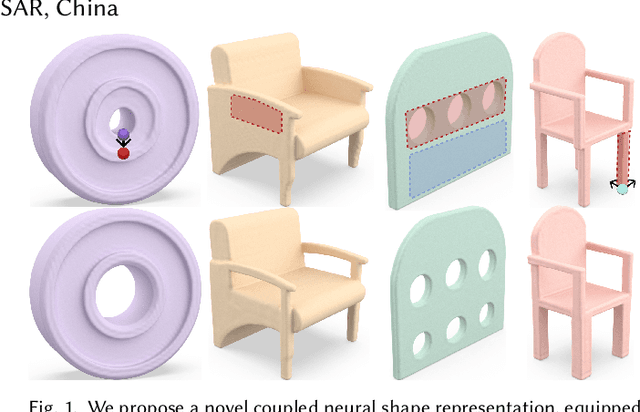

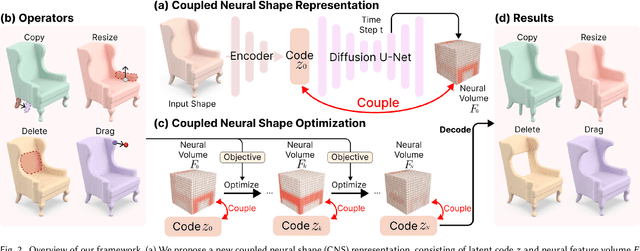

Abstract:This paper introduces a new approach based on a coupled representation and a neural volume optimization to implicitly perform 3D shape editing in latent space. This work has three innovations. First, we design the coupled neural shape (CNS) representation for supporting 3D shape editing. This representation includes a latent code, which captures high-level global semantics of the shape, and a 3D neural feature volume, which provides a spatial context to associate with the local shape changes given by the editing. Second, we formulate the coupled neural shape optimization procedure to co-optimize the two coupled components in the representation subject to the editing operation. Last, we offer various 3D shape editing operators, i.e., copy, resize, delete, and drag, and derive each into an objective for guiding the CNS optimization, such that we can iteratively co-optimize the latent code and neural feature volume to match the editing target. With our approach, we can achieve a rich variety of editing results that are not only aware of the shape semantics but are also not easy to achieve by existing approaches. Both quantitative and qualitative evaluations demonstrate the strong capabilities of our approach over the state-of-the-art solutions.
Make-A-Shape: a Ten-Million-scale 3D Shape Model
Jan 20, 2024
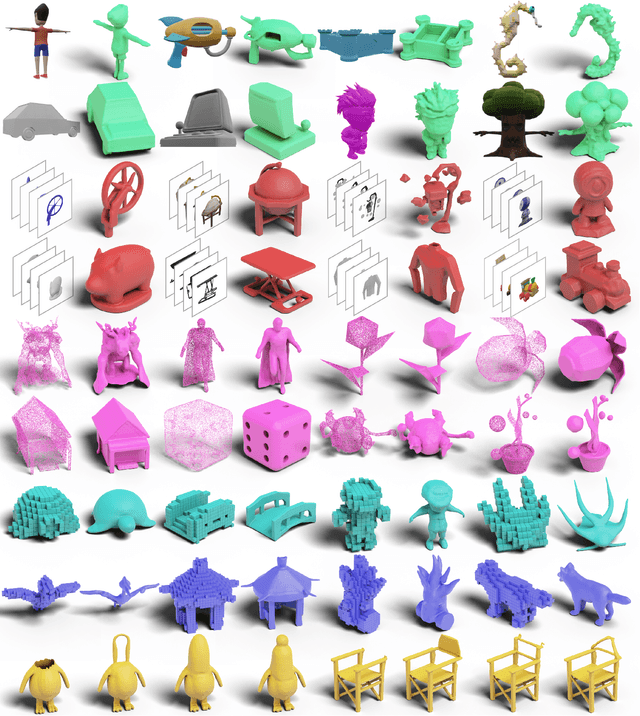
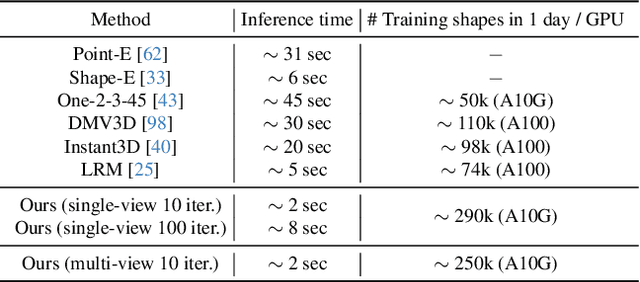
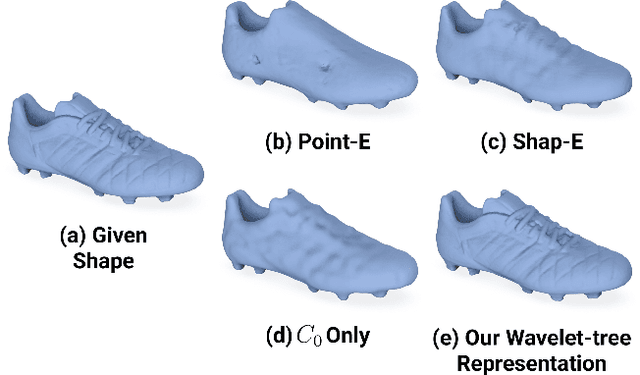
Abstract:Significant progress has been made in training large generative models for natural language and images. Yet, the advancement of 3D generative models is hindered by their substantial resource demands for training, along with inefficient, non-compact, and less expressive representations. This paper introduces Make-A-Shape, a new 3D generative model designed for efficient training on a vast scale, capable of utilizing 10 millions publicly-available shapes. Technical-wise, we first innovate a wavelet-tree representation to compactly encode shapes by formulating the subband coefficient filtering scheme to efficiently exploit coefficient relations. We then make the representation generatable by a diffusion model by devising the subband coefficients packing scheme to layout the representation in a low-resolution grid. Further, we derive the subband adaptive training strategy to train our model to effectively learn to generate coarse and detail wavelet coefficients. Last, we extend our framework to be controlled by additional input conditions to enable it to generate shapes from assorted modalities, e.g., single/multi-view images, point clouds, and low-resolution voxels. In our extensive set of experiments, we demonstrate various applications, such as unconditional generation, shape completion, and conditional generation on a wide range of modalities. Our approach not only surpasses the state of the art in delivering high-quality results but also efficiently generates shapes within a few seconds, often achieving this in just 2 seconds for most conditions.
EXIM: A Hybrid Explicit-Implicit Representation for Text-Guided 3D Shape Generation
Nov 03, 2023
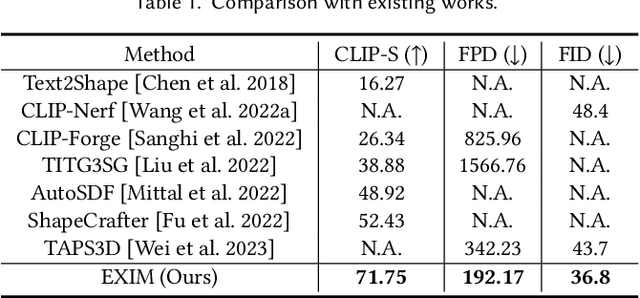


Abstract:This paper presents a new text-guided technique for generating 3D shapes. The technique leverages a hybrid 3D shape representation, namely EXIM, combining the strengths of explicit and implicit representations. Specifically, the explicit stage controls the topology of the generated 3D shapes and enables local modifications, whereas the implicit stage refines the shape and paints it with plausible colors. Also, the hybrid approach separates the shape and color and generates color conditioned on shape to ensure shape-color consistency. Unlike the existing state-of-the-art methods, we achieve high-fidelity shape generation from natural-language descriptions without the need for time-consuming per-shape optimization or reliance on human-annotated texts during training or test-time optimization. Further, we demonstrate the applicability of our approach to generate indoor scenes with consistent styles using text-induced 3D shapes. Through extensive experiments, we demonstrate the compelling quality of our results and the high coherency of our generated shapes with the input texts, surpassing the performance of existing methods by a significant margin. Codes and models are released at https://github.com/liuzhengzhe/EXIM.
SDF-Pack: Towards Compact Bin Packing with Signed-Distance-Field Minimization
Jul 14, 2023Abstract:Robotic bin packing is very challenging, especially when considering practical needs such as object variety and packing compactness. This paper presents SDF-Pack, a new approach based on signed distance field (SDF) to model the geometric condition of objects in a container and compute the object placement locations and packing orders for achieving a more compact bin packing. Our method adopts a truncated SDF representation to localize the computation, and based on it, we formulate the SDF minimization heuristic to find optimized placements to compactly pack objects with the existing ones. To further improve space utilization, if the packing sequence is controllable, our method can suggest which object to be packed next. Experimental results on a large variety of everyday objects show that our method can consistently achieve higher packing compactness over 1,000 packing cases, enabling us to pack more objects into the container, compared with the existing heuristics under various packing settings.
CLIPXPlore: Coupled CLIP and Shape Spaces for 3D Shape Exploration
Jun 14, 2023



Abstract:This paper presents CLIPXPlore, a new framework that leverages a vision-language model to guide the exploration of the 3D shape space. Many recent methods have been developed to encode 3D shapes into a learned latent shape space to enable generative design and modeling. Yet, existing methods lack effective exploration mechanisms, despite the rich information. To this end, we propose to leverage CLIP, a powerful pre-trained vision-language model, to aid the shape-space exploration. Our idea is threefold. First, we couple the CLIP and shape spaces by generating paired CLIP and shape codes through sketch images and training a mapper network to connect the two spaces. Second, to explore the space around a given shape, we formulate a co-optimization strategy to search for the CLIP code that better matches the geometry of the shape. Third, we design three exploration modes, binary-attribute-guided, text-guided, and sketch-guided, to locate suitable exploration trajectories in shape space and induce meaningful changes to the shape. We perform a series of experiments to quantitatively and visually compare CLIPXPlore with different baselines in each of the three exploration modes, showing that CLIPXPlore can produce many meaningful exploration results that cannot be achieved by the existing solutions.
 Add to Chrome
Add to Chrome Add to Firefox
Add to Firefox Add to Edge
Add to Edge